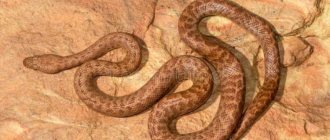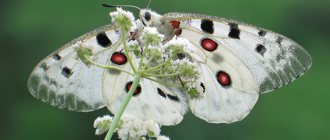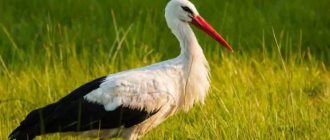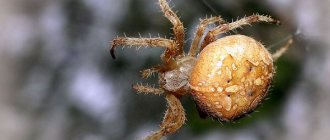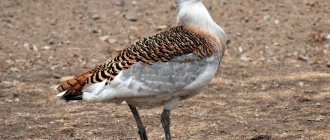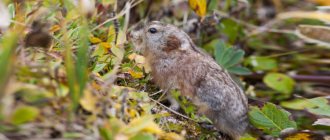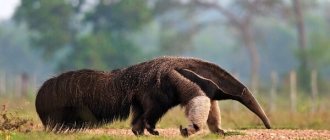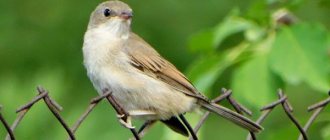Lizards belong to the squamate family, which is part of the suborder of reptiles. They are the oldest representatives of fauna on Earth, since their existence coincides with those distant times when dinosaurs lived on the planet. In addition, even the word “dinosaur” is translated from Latin as “large lizard.” At the same time, truly large representatives of lizards, as well as dinosaurs, disappeared from the face of the Earth. However, their smaller relatives survived and successfully adapted to the conditions around them, due to which they are still considered extremely common reptiles, found everywhere.
Agamidae
These are medium-sized diurnal lizards, and there are also very small individuals. They live on the ground, in trees, in burrows, in water, and some even fly. They live in Eurasia, Australia and Africa. They live everywhere except very cold areas. Let's look at some species from this family.
- Spinytails chose the northern part of Africa, the Near and Middle East, parts of India and Pakistan. They have a voluminous, wide body up to 75 cm in size. The head has a flattened appearance, the tail is thick and not long, all covered with tuberous spines, for which they got their name. The color is camouflage, the color of dark sand or alumina. A total of 15 species are known.
- Australia and New Guinea are home to Amphibolurinae , all local names of which include the word “dragon” - crested dragon, tropical, forest, bearded (their lower jaw turns black after stress, taking on the appearance of a beard), earless, etc. Most likely, their exotic appearance provoked such nicknames.
Many of them are decorated with spines, and the frilled lizard (Chlamydosaurus) , for example, has a completely menacing appearance. Her head is surrounded by a large fold of skin in the form of a collar, and she raises it like a sail if she is excited. It is about a meter in size, has a fiery terracotta color, and has sharp teeth and claws. All together this creates an eerie impression.
- Moloch, the “prickly devil” (Moloch), looks no less exotic The name itself, in honor of a greedy pagan deity demanding human sacrifices, suggests that this specimen looks frightening. Its entire body is covered with curved spines, and above the eyes these growths look like horns. And he, like a chameleon, can change color. But not as a disguise, but based on my mood and well-being. Only the body size lets us down, it is about 22 cm.
- Water dragons (Phusignathus) stand apart from others They do not live in Australia, but in Southeast Asia, Thailand, Cambodia, Vietnam and China. In Greek, their name means “swollen jaw,” and we know them as Chinese water dragons. They can stay under water for a long time and use their tail to swim. Many people keep these individuals at home.
The following people live in the Russian Federation:
- Caucasian agama (from the genus of Asian mountain), it is capable of inflating its body, huddled in a crack. And it’s impossible to get her out of there, because her whole body is tightly enveloped in small, rough scales.
- steppe agama . This baby, 12 cm long, usually has a camouflage color of gray-olive tones. But in extreme heat or after stress, it changes a lot. And here the gender difference is immediately visible. Males are a rich blue-black color, with azure markings on the back, only the tail takes on an egg yolk hue. And the females are the color of the sky or creamy greenish, with dark orange spots on the back.
- round-headed spinytail is a small lizard up to 14 cm with a tail. Lives in steppe and desert regions (Kazakhstan, Kalmykia, steppes of Stavropol, Astrakhan and Volgograd regions). Its muzzle has a sloping, streamlined shape, which is why it got its name. Very curious, pebbles and other inedible objects are often found in the stomach.
- The takyr roundhead is also an inhabitant of deserts. It has a flat and wide body, a short tail and spotted patterns in blue and pink tones. A distinctive feature is the vertical profile of the muzzle, the upper jaw almost vertically passes into the lip.
- the long-eared roundhead is our “beauty-beast”. In a calm state, it has a quite decent appearance - a patterned grayish-sand color and a not very long tail. But in case of danger, a metamorphosis occurs - it takes a threatening pose, tenses, spreads its legs, and puffs up. Then it opens its bright pink, toothy mouth, expanding it with protective folds, like large ears. An angry hiss and a curled tail complete the action, forcing the enemy to flee.
Features of character and lifestyle
Typically, lizards are characterized by a terrestrial lifestyle, but some species prefer to climb various vegetation and live in trees, while others prefer to bury themselves in the sand. Some lizards, like geckos and agamas, are skilled at moving on smooth surfaces, which is why they are often found among rocks.
Some representatives of reptiles are capable of gliding in flight, due to which they thus move from one tree to another.
There are lizards that have a rather long body and prefer to live in the soil. For example, the sea lizard chooses to live on the coast and often appears in the sea.
All reptiles differ in their activity schedules: for some, the daytime lifestyle is considered more common, while for others it is night or twilight. Most of the predators are diurnal, going out to hunt as dawn approaches. Reptiles are cold-blooded, which is why they do not tolerate temperature changes well. The rays of the scorching sun, from which they have to hide in the shade of vegetation, are also not suitable for their skin.
Some members of the family have a “third eye” located in the parietal region. Despite its inability to distinguish shapes, it is good at detecting light levels. Also, such a “third eye” is characterized by the ability to regulate the duration of exposure to the sun due to sensitive perception of the influence of ultraviolet rays.
Lizards have a calm character: they prefer not to enter into fights or alliances. Most of all, they like a solitary life without contact even with their relatives. The only time when lizards can come together is the mating season. Moreover, such contacts are not limited only to the need to conceive offspring. Thus, males wage fierce battles among themselves for the possibility of possessing a female and territory.
Question to the expert
How do lizards winter in the wild?
With the arrival of cold weather, the body temperature of reptiles begins to decrease, making it difficult to obtain food, which forces the lizards to reduce their natural activity. Lizards spend the winter in the same way as other animals by hibernating. However, they do this not like ordinary reptiles, but rather like squirrels or birds. Thus, lizards collect dry branches and leaves, from which they subsequently build their own nest. Preparation for wintering begins at the end of September and lasts until mid-October. They usually create burrows themselves, placing them close to tree roots and old stumps. In the absence of such an opportunity on the landscape, reptiles are engaged in digging holes on their own at a depth of 15-20 cm underground. In addition, they can adapt rodent burrows, cracks in the ground, summer cottages, etc. for their purposes. The main thing is that the hole is warm and dry enough. At the same time, unlike other animals, lizards can quickly switch to an active lifestyle, so terrarium lovers are not always able to observe the classic hibernation of their pets.
Chameleons
We all know that these tree dwellers can change their body color to suit their surroundings. This occurs due to the special properties of the skin. It contains pigments of different colors in special branched cells - chromatophores. And, depending on their reduction, the pigment grains are redistributed, creating the “right” shade.
The picture is completed by the refraction of light rays on the surface of the skin containing guanine, a substance that gives a silvery-pearl shade. The usual body length is up to 30 cm, only the largest ones grow beyond 50 cm. They live in Africa, the Middle East, southern Europe and India.
They have been spotted in California, Florida and Hawaii. Yemen and panther chameleons (inhabitants of Madagascar) are often bred at home The first ones are considered the largest in the family, reaching 60 cm. Sun spots are scattered on the green “lawn” of the sides.
The head is decorated with a crest. The rigid tail with a transverse stripe is twisted into a ring at the end. The latter grow up to 52 cm, have a beautiful bright emerald color with patterns and spots. They can change shades to brick red. They love warm, humid climates. They live in captivity for up to 4 years.
Pets
More and more people are keeping unusual pets in their homes. These can be insects, spiders and reptiles. Lizards take up the lion's share of this list. The reason for such popularity of reptiles lies in their cute appearance, calm behavior and relative friendliness. Lizards can easily replace a cat or a dog.
Panther chameleon
Furcifer pardalis is native to Madagascar. The lizard looks very bright, and its color largely depends on the place where it was born. Males can reach a length of 50 cm, but only in natural conditions. When kept at home, their body length rarely exceeds 25 cm. Females are even shorter. The lifespan of a panther chameleon does not exceed 6 years.
Females have a less bright color, which is almost the same in different regions of their habitat. Males, on the contrary, are very bright and very different from each other. By their appearance, experienced specialists can determine where this or that individual appeared. The most popular varieties are:
- Ambilobe chameleon. Born in the northern part of the island between two villages.
- Sambava. Lives in the northeastern part of Madagascar.
- The tamatawe chameleon is a coastal resident in the east of the island.
They easily feed from people's hands.
At home, the panther chameleon should be kept in a terrarium. In the first months of life, a lizard needs a small home measuring 30x30x50 cm, but then it will need a larger home.
To bring the pet's living conditions closer to natural ones, branches, artificial and live plants are placed inside the terrarium. Of the latter, dracaenas and ficuses should be highlighted. Chameleons love to climb steep surfaces, which means that the serpentarium should contain driftwood and vines. The top of the dwelling must be tightly closed. If the lid is removed, the chameleons, despite their slowness, will quickly escape.
Panther and other types of chameleons do not like human contact. They love peace. If you take the reptile in your arms, then you need to do this only from below. Seeing movement from above, the reptile will regard it as a threat. Over time, chameleons get used to their owners and even begin to recognize them. They readily approach people while feeding.
Water dragon
This reptile prefers to live in close proximity to bodies of water, on the banks of which there are large stones or branches. The agama basks on them on sunny days.
The lizard has strong paws with large claws, which are not weapons, but a tool for convenient movement on various surfaces. A strong and wide tail allows the reptile to swim quickly.
The water agama is considered a large lizard. Taking into account the tail, the length of the female can reach 60 cm. Males are even larger - up to 1 meter. Males differ from females not only in size, but also in color. Moreover, these differences in young lizards are rather weakly expressed.
To keep a water agama at home you will need a very large terrarium. Young individuals can huddle in a 100-liter aquarium for some time, but then the living space for them will have to be significantly expanded.
It’s not for nothing that Agama is called a water creature – she loves to be in the water
Thick branches must be placed inside the terrarium. You can use paper and coconut shavings as a backing. But sand will not work - the lizard will eat it .
The terraria should have a heating zone with a constant air temperature of +35 °C. It is better to provide heating with the help of lamps, since lizards spend most of their time climbing on snags.
Agamas love to swim, so you need to place a pond inside the terrarium. In addition, you will have to maintain air humidity at least 60%. This can be done using a spray bottle.
There should not be 2 males in one terrarium. They will not be able to get along and will definitely fight.
Leopard gecko
The leopard gecko or spotted gecko is perhaps the most popular species among those who like to keep exotic animals at home. This lizard is very calm and peaceful. She feels great in small terrariums. The gecko is easy to care for. In addition, this type of reptile is distinguished by a variety of colors.
In nature, the leopard gecko lives in the dry steppes and rocky semi-deserts of Afghanistan, Iran and Pakistan. The lizard is active at dusk and early morning. At this time, the air temperature is most comfortable for her.
Spotted geckos prefer to live alone. They jealously guard their territory. Males prefer to communicate with females only during the mating period.
One gecko will feel great in a 50 liter terrarium. However, if the owner plans to breed these reptiles, then he will have to buy a larger terrarium.
Leopard gecko does not know how to walk on smooth terrain.
Leopard gecko does not know how to climb on smooth surfaces , so the house does not need to be covered with a lid. But if there are other pets at home, especially cats, then it is better to close the terrarium.
You can safely keep several females at once in one house if they are of the same age and size. There will be no hostility between them. But the males will certainly fight. Moreover, males do not get along with females. They will take food from females and kill them, so males should be kept alone.
Spotted geckos should have areas of high and low temperature in their terrarium. The maximum temperature is +32 °C, the minimum is not lower than +22 °C. This parameter must be monitored with two thermometers. Overheating or hypothermia will lead to illness in your pet.
Collared iguana
This medium-sized lizard lives in the southeastern United States. Its maximum length, including its tail, is 35 cm. In natural conditions, it lives for about 8 years, and in captivity - no more than 4.
The collared iguana is a very strong and fast predator. According to biologists, if its size were comparable to the size of monitor lizards, it would easily displace the latter. This reptile effectively hunts other reptiles and rodents. She does not disdain insects either.
The iguana moves very quickly. Accelerating to a speed of 26 km/h, it attacks its prey and kills it with its powerful jaws in a few movements.
The lizard has a high metabolism, so keeping it at home is not easy, since you have to feed it often. Large cockroaches, beetles, and mice serve as food.
An iguana needs a spacious enclosure with an ultraviolet heater. You can keep it in a terrarium, but then it must be very large. The temperature in the lizard's home should be maintained at +27 °C, and in the heating zone - up to +41−43 °C. There is no need to make a separate pond, just install a drinking bowl. You should spray water from a spray bottle from time to time.
When interacting with iguanas, you must be careful. They have a hard time getting used to human hands and, if handled carelessly, can cause injury with their jaws.
Collared
Inhabitants of North America. They do not have many typical features of the infraorder Iguanaiformes - a longitudinal ribbed stripe on the back, a throat pouch, a rostral shield, spines and growths, scales on the ears and fingers. Therefore, they were taken out of the iguana family, elevated to the rank of their own family. A distinctive feature is the presence of a colorful, bright collar.
Iguanas
They live in America, as well as on the islands of Fiji, Galapagos and the Caribbean. Among them, true iguanas are recognized as the largest - up to 2 m in length. They are distinguished by pleurodont teeth, which grow on one side to the jaw bones. Interestingly, the lost tooth is soon replaced by a new one. Such capabilities are usually inherent in members of other families, but not agamas.
What to feed at home?
And many exotic species of lizards are very popular terrarium animals, among them the Yemen chameleon, bearded agama, true iguana and others. With proper care, lizards reproduce well and feel at ease. But if you decide to get a pet lizard, then you will be faced with the question of how to properly feed such an exotic pet.
Fortunately, the lizard is not whimsical in terms of food intake; in the warm season it needs to be fed three times a day, and in winter, due to the low activity of the lizard itself, it can be fed only twice a day. Well, mealworms, grasshoppers, spiders, fresh chicken eggs and pieces of raw meat are suitable food for the lizard. They say that lizards are very fond of a mixture of chopped boiled chicken, grated carrots and lettuce. It is also very important that the lizard always has fresh drinking water in its terrarium.
Masks
A monotypic family found in the West Indies and Florida. They are able to curl their tail into a spiral. They got their name from the wide black stripe that runs from the nose through the eyes. The most typical of this family is the common masked iguana, which lives in Haiti.
Anolis
Inhabitants of America and the Caribbean Islands. They have a small slender body, most often the color of young or withered grass, and long fingers. Males have a scarlet throat sac, which is inflated and protruded during the mating season or at times of danger. Because of this, many of them are called red-necked. May change color depending on condition.
Natural enemies
Lizards, especially small ones, have a significant number of natural enemies due to their small size and the almost complete absence of defense mechanisms. Therefore, nature took care of reptiles, giving them the opportunity to defend themselves from enemies by dropping their tail, which remains in the hands or teeth of the enemy. After it is dropped, the lizard successfully slips out of the grip and hurries to run away as far as possible.
Moreover, each lizard has its own unique defense mechanisms, which differ depending on the species. For example, long-eared roundheads are capable of spreading their limbs wide and tensing their body, which together creates a terrifying pose when colliding with an enemy. If this fails to scare off an enemy, the lizard may use its teeth and claws in open combat.
Among the most characteristic enemies of lizards are the following:
Birds of prey like hawks, owls or eagles.
- Foxes.
- The Bears.
- Wolves.
- Snakes.
Sometimes even their own relatives, who do not mind feasting on smaller lizards, become a problem.
Corytophanidae
They live in central North and northern South America. They are called helmet or casque-headed for the special structure of the head and for the ridge that goes to the tail. There are several basilisks among them. It is unknown why they were named after a mythical creature with a freezing gaze.
Perhaps for the ability to look for a long time without blinking. Or maybe for the ability to run on water, quickly moving its paws. At the same time, they can reach speeds of up to 12 km/h. The remaining families in this infraorder also live in America. The next infraorder - Gecko-like - contains 7 families.
Interesting Facts
- Basilisk lizards are able to move on water. And this is not a biblical miracle, but a physical law of nature; movement through the water is achieved by quickly and very often moving the lizard’s hind limbs.
- Lizards, like many other animals, are color blind, but unlike many of them, who see the world around them in black and white, lizards look at it through orange glasses in the most literal sense - they see the whole world as different shades of orange.
- Colombian gourmets consider the eggs of some lizards to be the greatest delicacy. There they even specially catch pregnant female monitor lizards and iguanas, cut their belly, take out the eggs, rub wood ash into the wound itself, after which the female is released, and the eggs end up on the dinner table.
Gecko
All geckos are distinguished from other lizards by their karyotype (an individual set of chromosome characteristics), as well as a special muscle in the ear area. They do not have bony temporal arches. In addition, most geckos have prehensile and long toes covered with fine hairs.
This allows them to move along any vertical surface. Looking at the types of lizards in the photo , you can immediately recognize the gecko. They are often photographed on glass and even on the ceiling. A small gecko weighing up to 50 g is capable of holding a load weighing up to 2 kg.
The following people live in the Russian Federation:
- squeaky gecko , a small 8-centimeter inhabitant of the area near Mount Bolshoi Bogdo in the Astrakhan region, allocated to the Bogdinsko-Baskunchaksky Nature Reserve. Listed in the Red Book. The length of the body is equal to the length of the tail - all about 4 cm. Covered with granular scales. Painted in light ocher tones with a dusty coating, the belly is light. There are at least five wide transverse coffee-colored stripes on the back.
- Caspian gecko or thin-toed gecko. There are island and main subspecies. Active both day and night. Loves rocky places, hides in rodent burrows.
- gray or bare-toed gecko Rousson , we live in Kazakhstan and Ciscaucasia. A very small specimen, including the tail, it is 5 m in length.
Appearance
There is no uniformity in the appearance of lizards, with the exception of the background coloring of the body, designed to camouflage the reptile among its native landscape. Most of the lizards are colored green, gray, brown, olive, sand or black, whose monotony is enlivened by various patterns (spots, stains, diamonds, longitudinal/transverse stripes).
There are also very noticeable lizards - the long-eared round-headed lizard with a scarlet open mouth, the bearded dragon, and colorful (yellow and orange) flying dragons. The size of the scales varies (from small to large), as does the way they are laid on the body: overlapping, like a tile roof, or end to end, like tiles. Sometimes the scales transform into spines or ridges.
In some reptiles, such as skinks, the skin gains special strength from osteoderms, bony plates that are located inside the horny scales. The jaws of lizards are lined with teeth, and in some species, teeth even grow on the palatine bones.
This is interesting! The methods for attaching teeth to the oral cavity vary. Pleurodont teeth are periodically replaced and therefore do not sit firmly on the inside of the bone, unlike acrodont teeth, which are not replaced and completely fuse with the bone.
Only three species of lizards have acrodont teeth - amphisbaenas (two-walkers), agamas and chameleons. The limbs of reptiles are also structured differently, which is due to their way of life, adapted to a certain type of earth’s surface. In most climbing species, geckos, anoles and some skinks, the underside of the fingers is transformed into a pad with setae (hair-like outgrowths of the epidermis). Thanks to them, the reptile tenaciously holds onto any vertical surfaces and quickly crawls upside down.
Scalefoot
Legless reptiles, very similar to snakes. However, they do not make hissing sounds, but clicking sounds. The largest ones grow up to 1.2 m, the small ones – up to 15 cm. They range from straw to peat in color. They live mainly in Australia and New Guinea. The infraorder skinks also includes 7 families
Orders of reptiles
Biologists divide all lizards into 6 orders, each of which includes about thirty families. The orders of reptiles are:
- Skink-like. The order is distinguished by rich species diversity. It includes real lizards, widely represented in Russia, but most species live in tropical areas of the planet. Skink-like reptiles are found in South America and Africa, Madagascar and Cuba. Some varieties were discovered by scientists in the Sahara Desert.
- Iguanas. This order includes 14 families of reptiles. The most famous of these is the chameleon, found in South America and Madagascar.
- Gecko-like. Reptiles belonging to this order are considered rare. It includes lizards that do not have legs. They are found in Australia.
- Fusiform. These include monitor lizards.
- Worm-like lizards. These are the so-called scale insects. Externally, reptiles look more like huge earthworms. They can be found in the tropical rainforests of Indochina, Indonesia and Mexico.
- Monitor lizards. These lizards are very large. Their weight often exceeds 5 kg. There are a lot of legends about them.
There is only one type of poisonous lizard - the poisonous lizard. When attacking their prey, they not only bite it, but also inject dangerous poison under the skin.
Some species can be pets
Real lizards
They live in Europe and Asia, as well as Japan, Indonesia and Africa. There are several species living in the United States (wall lizards). In the Russian Federation live: Alpine, rock, Caucasian, Dagestan, Artvinskaya, meadow, Georgian lizards, as well as foot-and-mouth lizards - Mongolian, multi-colored, ocellated, Gobi, fast, quick, medium, striped, slender snakehead, Amur and Korean long-tailed lizard, viviparous lizard.
The latter species is distributed even to the polar regions, as it is less susceptible to cold. For the winter, they go underground to a depth of 40 cm. They swim well. Small teeth are not able to chew protein foods, so they swallow worms, insects and snails whole.
Lizards located in the vicinity of Moscow
There are a large number of different species of lizards that live in the Moscow region. Let's look at some of them.
Brittle spindle - this type of lizard has no legs and is very often confused with a snake. It lives in thickets of bushes or forests. This reptile feeds on insects and worms.
The main distinguishing characteristic from snakes is the movable eyelid and even scales throughout the body. The coloring of juveniles and adults is different. Juveniles are silver or golden in color, while adults are dark brown.
Viviparous lizard - likes to be in damp places. In the Moscow region they wake up from hibernation in mid-April.
The fast lizard loves to be in sandy places most of all, so it is easy to see in gardens, meadows, and clearings.
Skinks
They live everywhere except Antarctica. They have smooth fish-like scales. The temporal arches are well developed. Among them there are such striking representatives as blue-tongued skinks - gigantic or tiliqua. They live in Australia and the islands of Oceania.
Their size is not so impressive - up to 50 cm. But the body is very wide and powerful. An individual touch is a wide tongue of deep blue color. Perhaps these are the consequences of the diet. They prefer to eat shellfish and plants.
Among skinks, there are species with unusual eyes - with a transparent window on the lower eyelid. They always see, even when they close their eyes. And gologlaz have transparent eyelids fused together, like snakes. These “lenses” allow them to absolutely not blink.
Members of the family represent a smooth transition to legless forms - from normally developed limbs and five fingers to shortened and reduced variants, and finally, completely legless. There are short-tailed, prehensile-tailed and spiny-tailed species, as well as semi-aquatic, floral and desert species.
In the Russian Federation live:
The long-legged skink is found in Central Asia, Eastern Transcaucasia and southeast Dagestan. Up to 25 cm in size, movable eyelids, very brittle tail. The color is brownish-olive with grey. Bright and variegated longitudinal stripes are visible on the sides.
Far Eastern skink, resident of the Kuril and Japanese islands. Olive-gray in color with a bluish-pearl long tail. Included in the Red Book of Russia.
Fusiformes – 3 families
Veretenitaceae
Among them there are crawling, snake-like ones, and ordinary ones - on four five-toed paws. All scales are supported by bone plates called osteoderms. Some have stretchable folds of skin on their sides, which make it easier for them to breathe and swallow food. Unlike snakes, they have movable eyelids and auditory openings. The jaws are strong, the teeth are dull. There are viviparous species.
In the Russian Federation live:
- The brittle spindle or slow spindle is a legless lizard up to 50-60 cm long. Its shape resembles a spindle. The color is reddish-gray or brown, or bronze-copper, for which it received its second name.
- The yellowtail or capercaillie is also a legless lizard. Or rather, there are still hind limbs, but they represent very small tubercles near the anus. It can reach 1.5 m in length. The head is tetrahedral, with a pointed muzzle. The color is olive-gray with brick tones.
Monitor lizards - now there are 3 families left
general characteristics
Lizards are considered representatives of a separate evolutionary lineage, despite their close relationship with snakes. In fact, lizards are considered direct descendants of snakes, but this does not prevent them from being separated into a separate branch of development. Like snakes, lizards belong to the squamate order. At the same time, lizards are considered representatives of different evolutionary groups, despite the unification based on the presence of certain features of physiological development, for example, the possibility of losing limbs.
All lizards have movable eyelids and visible openings that represent ear canals. Most lizards have two pairs of limbs, but this does not always characterize all representatives included in this suborder. To determine whether reptiles can be classified as lizards, the internal structure of the body is usually assessed.
Most lizards have a rudimentary sternum and shoulder girdle, which is absent in snakes.
There is a wide variety of variations in the appearance of lizards. Their background color is directly related to the need to camouflage among the natural conditions of the landscape, which determines the presence of different options for the natural color of lizards. The most common are the varieties in which the color is green, gray, brown, or sand.
Lizards are characterized by the presence of various spots, stripes and stains, which can sometimes form bizarre geometric shapes. Some representatives of the species can change color based on the situation. Mimicry based on color changes is common among lizards.
Lizards can also have distinctive colors like the Tokay gecko.
The scales of lizards are located differently and depend on the species of reptile. Thus, the arrangement of scales can be overlapping, in the form of a tiled roof, end-to-end, etc. Often the scales are formed in the form of peculiar spikes. In some lizards, the scales acquire especially durable properties due to the osteoderm - bony plates located inside the horny scales.
Lizards' mouths are filled with teeth. In some reptiles, certain types of teeth are located near the palate. Pleurodont teeth are teeth that change periodically, which is why they are not fixed too firmly. Acrodont teeth are permanent; they are firmly located in the mouth due to the fact that they are fused with the bones. This type of teeth is characteristic of a small number of lizards.
The bristles are quite thin, thanks to which reptiles can freely stick to different surfaces, including fairly smooth ones.
The limbs of reptiles are formed in different ways: their structure depends on the natural living conditions. For example, lizards, which require the ability to quickly climb various surfaces, have tenacious fingers due to the presence of bristles on the pads.
The tongue of lizards also differs in shape and size. Moreover, in all representatives of the suborder it is quite flexible, mobile and freely protrudes from the mouth.
Some reptiles can even catch fish using the flexibility and strength of their tongue.
The main weapon of lizards, however, remains their teeth. With their help, they grab prey and cut it up. For example, a monitor lizard with its sharp teeth can actually cut its prey into pieces. In addition, the suborder of lizards also includes one poisonous representative, the venomtooth, which is capable of transmitting poison to the victim along with its bite, which ultimately helps them cope with the enemy.
Poll: Have you ever held lizards in your hands?
Yes, I did
62.5%
No, I didn't hold it
37.5%
Voted: 8
Venomous teeth
Poisonous species of lizards , two of them are currently known - Arizona and Mexican. They have a dense, ridged body, a short tail with reserves of fat and a flat head. Paws are five-fingered with sharp long claws. The coloring, like many dangerous creatures, is warning.
Variegated, with bright yellow-red spots on a dark background. They prefer rocky desert areas, but do not like extreme dryness. But they love to swim, and row with their paws like oars. In winter they hibernate. Usually slow, but develop good speed in water.
They love bird and turtle eggs, although they feed on all living things. They search for prey using their tongue, which is constantly protruding and vibrating. The venom from the bite is not fatal, but it brings very unpleasant sensations - swelling, enlarged lymph nodes, difficulty breathing, dizziness and weakness. In addition, the wound may become infected. But they themselves do not attack people. Typically, bites occur during capture or after poor conditions in captivity.
Difference from newts
Also, sometimes lizards are confused with newts, and, of course, they have a lot in common: similar structure of paws and body, snake-like head, long rounded tail, movable eyelids and much more. But there are still a number of differences between it:
- The most important difference is the different structure of the skin; if lizards have scaly skin, then in newts it is completely smooth and slimy to the touch.
- Newts do not know how to throw off their tail, while lizards easily and simply get rid of this part of their body in case of danger.
- Lizards have a hard and ossified skull, while newts have a cartilaginous skull.
- While lizards breathe exclusively through their lungs, newts are able to breathe through both their lungs and gills, and even through their skin.
- If lizards reproduce by laying eggs, then newts conduct their reproduction process like fish - in water and through spawning.
Earless monitor lizards
They live in Borneo (Kalimantan). The color is reddish-brown, with brown longitudinal stripes. The tail is long and narrow, making up half the length of the entire half-meter body. There is no external ear opening. This is a very rare species of lizard . Now there are no more than 100 individuals left.
Reproduction
During the mating season, males of many lizard species acquire bright colors. They are characterized by peculiar courtship games, during which the male demonstrates bright body color in front of the female, taking specific “courtship” poses, to which the female responds with certain signaling body movements, consisting, for example, of swaying or trembling of the raised front legs and wriggling of the tail.
The vast majority of lizards lay eggs, the number of which in one clutch ranges from 1-2 in the smallest species to 8-20 in medium-sized ones and several dozen in large lizards. The eggs are enclosed in a thin, moisture-permeable, colorless, leathery shell that can stretch during embryo development. Usually the female lays her eggs in a hole or shallow hole, then covering it with soil. Eggs are often laid under stones, in rock cracks, in hollows or under the bark of trees, in wood dust, and by some geckos they are glued to tree trunks and branches.
A minority of lizards are ovoviviparous. Their eggs, devoid of a dense shell, develop inside the mother’s body, and the cubs are born alive, freeing themselves from the thin film that covers them in the oviducts or immediately after birth. True viviparity has been established only in some skinks and American night lizards Xanthusia, the embryos of which receive nutrition through the false placenta - blood vessels in the walls of the mother's oviducts. Viviparity is usually associated with harsh living conditions, for example, living in the far north or high in the mountains.
In most cases, having laid eggs, the female never returns to them, and the developing embryos are left to their own devices. Real care for the offspring is observed only in some skinks and spindles, the females of which wrap themselves around the laid eggs, periodically turn them over, protect them from enemies, help the young free themselves from the shell and, remaining with them for the first time after hatching, give them food and protect them in case of danger .
Some species of lizards lay eggs with almost fully developed embryos, so the young can hatch within the next few days. By the time of hatching from the egg, the embryos develop a special egg tooth in the front corner of the mouth, with which, shaking its head, the young lizard, like a razor, cuts a gap in the egg shell to exit. Recently, the phenomenon of so-called parthenogenesis has been discovered in a number of lizards, when females lay unfertilized eggs in which normal offspring develop. There are no males during parthenogenesis, and such species are represented only by females.
Monitor lizards
The largest of them, undoubtedly, is the famous Komodo dragon. The recorded maximum size of its body is 3.13 m. The smallest is the short-tailed Australian monitor lizard with a body length of up to 28 cm. Monitor lizards have a completely ossified skull, an elongated body, a neck, and a forked tongue.
They walk on almost straightened limbs. The head is covered with polygonal bony scutes. They live in Asia, Australia and Africa. They prefer a diurnal lifestyle, with the exception of a few species - dark, striped and Komodo monitor lizards.
The latter exhibited parthenogenesis (same-sex reproduction). That is, females can give birth without males, their eggs develop without fertilization. All monitor lizards are oviparous. Dibamia -1 family.
Vermiforms are earless, eyeless and legless creatures that live in the earth. They dig tunnels and are very similar to earthworms. They live in the forests of Indochina, New Guinea, the Philippines and Mexico. Superfamily Shinisauroidae with one family.
The crocodile shinisaurus lives in southern China and northern Vietnam. Body length is about 40 cm. Currently, domestic species of lizards are increasingly decorated with this species. Special methods for breeding it in a terrarium have been developed.
Habitats
Where do lizards live? Lizards live on all continents, with the exception, of course, of Antarctica. In general, they love warm climates and can be found in forests, meadows, steppes, and deserts in any part of the world. They move well on any surface and cling tightly to them with their paws.
Interesting fact: rock lizards are excellent jumpers; the height of their jumps can sometimes reach up to 4 meters.

